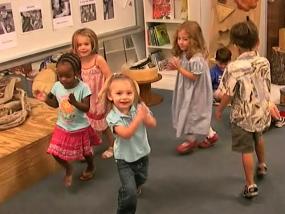Why Children Play Follow-Me

What do the three-year-old children in this video clip gain from playing the game of following one another in a circle? At Videatives we like to reveal what children know and to find the cleverness of children during ordinary moments. For example, are there some children whose strategies keep the game going for the others, i.e. the leaders if you will? If so, what are these children doing to maintain the game? What can you say about the game itself that offers children of different levels an opportunity to enter? If you like, focus on one child and lay out the development of that child's participation in the game. What might you say about the emergent structure of the game and how the game itself changes to accommodate what is happening to individuals as the game progresses? Why do you think children enjoy a repetitive game that does not have a targeted or defined ending the way the game of “Ring Around the Rosey” has with its defined ending, "All fall down”? What actually occurs in this specific video clip that portrays the value of these sorts of games for children? We thank the Beauford Elementary School, South Carolina, for allowing us to present this video clip to you.
Winning entry from Marianne Torbert, Temple University
To put into a short paragraph all that is happening with the children in the Follow-Me video is indeed a difficult challenge.
What are the children gaining from playing this game? Probably first and foremost the joy and celebration that comes from being a contributing part of a group, a sense of belonging, a sense of growth, and “I can.”, “I am able.” feelings. There is also the opportunity to practice: accepting and overcoming a challenge; focusing and refocusing; body-space relationships; reading one’s environment; perseverance; social/emotional self-control; decision making; and an opportunity to be a leader or a motivator. These are increased not only by the repetitive nature of the activity with the opportunity to try again, but also by: the many choices of the ways and levels of involvement that each child can choose at any point in time; to buy out when one wishes to and to then buy back in anytime one want – this is less available in activities with a targeted or defined ending; the opportunity to help or be helped, for sharing with and caring for others (pausing to help with another’s shoe). The value of the gains and opportunities within this type of game is best portrayed and evaluated by their perseverance, the joy and celebration seen on the children’s faces, their shouting challenge of “Follow Me”, and in their bodily motions.
Length of stand-alone master video clip: 1 minute 40 seconds
Highlight the text above and paste to a document to have your own copy.
Keywords: Threes, Body, Children-Children, Movement, Imitation, Leadership, Game Rules
